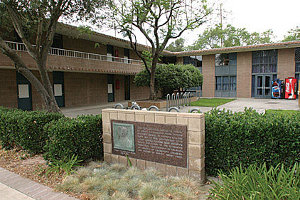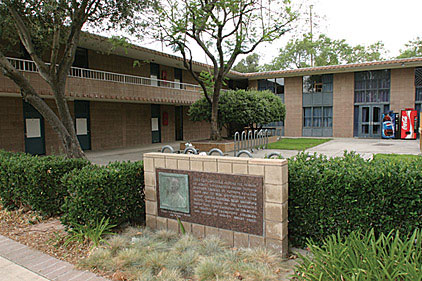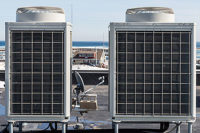Engineering-oriented school engineers VRF upgrade for old dorms
Established in 1955 and named after Harvey Seeley Mudd, a successful California mining engineer, Harvey Mudd College (HMC) is a private, residential liberal arts college of science, engineering, and mathematics located in Claremont, CA. HMC is one of the institutions of the contiguous Claremont Colleges, which include Scripps, Pitzer, and Pomona. In 2010, U.S. News and World Report ranked HMC the second-best undergraduate engineering program in the U.S., and Forbes in 2011 ranked the college 44th in its list of America’s Top Colleges, ahead of such prestigious universities as Cornell, the University of Pennsylvania, and Georgetown.
THE HARVEY MUDD COLLEGE DORMITORIES

|
|
A VRF zone system allows students to control their environments in their dorm rooms at this California college. |
The majority of HMC’s 738 undergraduates live on the college grounds, a striking 38-acre campus located 35 miles east of downtown Los Angeles. Each of the college’s eight dormitories (dorms) holds approximately 100 students.
The East dorm, named Mildred E. Mudd Hall after the wife of Harvey Mudd and completed in September 1957, was the first dorm constructed, opening its doors just in time for the college opening. The West dorm (West Hall) was completed one year later, in September 1958, followed by the North dorm (North Hall) in September 1959. Mildred Marks Hall was completed in 1968, followed by Atwood (1981), Case (1985), Linde (1993) and Sontag (2004). For the first 50 years (from 1957 to 2007), HMC students had no air conditioning in their dorm rooms. During this period, many students would bring window A/C units to keep cool during the warm spring and fall days.
SEARCHING FOR AN IDEAL HVAC UPGRADE
In the process of undertaking earthquake retrofit work on the West dorm in 2007, the HMC board instructed facilities director Tom Shaffer to investigate possible modernization of the 50-yr-old HVAC systems in the oldest dorms (West, East, and North). These consisted of hydronic (radiator) heating from a hot water boiler system in each building — and no air conditioning systems. At first, Shaffer considered installing a dedicated hydronics boiler and pulling chilled water from the HMC centralized plant into individual four-pipe fancoils in each dorm room. He knew, however, that running chilled water piping to all eight dorms from the central plant at the opposite end of the campus would be cost-prohibitive.
Shaffer held meetings with several HVAC contractors familiar with the four-pipe installation, but he also did his own research.
Shaffer’s online research soon led him to the Mitsubishi Electric website, where he discovered variable refrigerant flow (VRF) zoning technology involving multi-split heat pump systems using multiple indoor units connected to a single outdoor unit. Shaffer decided that VRF zoning was worth looking into for his three dormitories. A call to the Mitsubishi Electric Cooling & Heating headquarters in Georgia prompted a next-day get-together with a local commercial sales manager. A meeting and complete walkthrough of the West dorm convinced Shaffer that the Mitsubishi Electric VRF zoning system was exactly what he was looking for. The Board of Trustees agreed, allowing Shaffer to install this new system in West Hall as a beta test. He quickly engaged the services of a mechanical engineer to design the system. Final bid for the installation came in at one-third the cost of the four-pipe hydronic system, and about half the cost of a conventional system.
A SUPERIOR VRF ZONING SYSTEM FOR DORMITORIES
Searching for the right contractor for this West Hall installation, the Mitsubishi Electric rep contacted Randy Scholnick, director of sales for Sirius Mechanical, Moreno Valley, CA. Sirius had recently installed a similar Mitsubishi Electric system at the Kappa Kappa Gamma (KKG) sorority house, University of Southern California, Los Angeles. The KKG installation was a retrofit of an existing dormitory, so it made complete sense for Sirius to get the nod for the West Hall system installation. “We liked the challenge of taking an existing building like West Hall and retrofitting the Mitsubishi Electric VRF zoning system,” Scholnick said. “What makes this superior to other VRF zoning systems is that it is a true two-pipe system, versus a competitor’s hybrid two-pipe/three-pipe approach, or especially a four-pipe system. Installations take less time and less labor, which translates into lower costs.
“For another thing, the VRF zoning system allows for refrigerant line flexibility, remote locating of outdoor heat pumps, and individualized zone control with fancoils in each room able to switch simultaneously from cooling to heating. For aesthetic reasons, the Mitsubishi Electric wall-mounted fancoils are stylish in comparison with the competitors’ indoor units,” he explained.
Scholnick further explained that VRF zoning systems are ideal for old, historic, or legacy buildings that were designed and built long before the invention of air conditioning. In contrast, VAV systems still require ductwork from the fancoils into their zones, which can be quite a distance from the cooling and heating source. Wall-mounted VRF zoning systems eliminate ductwork and operate at higher efficiencies because the fan coils are in the room they’re controlling. Even the ducted fancoils that are installed in chases in each dorm room require almost no ductwork. When a contractor trades refrigerant lines for ductwork, efficiencies increase dramatically.
THE RESULTS
“For more than 50 years, the eight residence halls at Harvey Mudd College had no air conditioning systems to provide comfort to our more than 750 students, most of whom board on campus,” said David Dower, assistant vice president, planning and construction, Harvey Mudd College.
The college installed the first Mitsubishi Electric system in the oldest residence hall, West Hall, in August 2007. Installation at the Mildred E. Mudd Hall (East Hall) followed in August 2008, with installation at the North Hall occurring the following year.
“In the course of these last four years, we have received rave reviews from students in each of the three dormitories — they all like the individual room controls,” continued Dower. “The equipment was easy to install in our 50-yr-old buildings, and the systems have performed well. We are quite delighted with all these benefits, which have provided a great return on our investment.” ES




